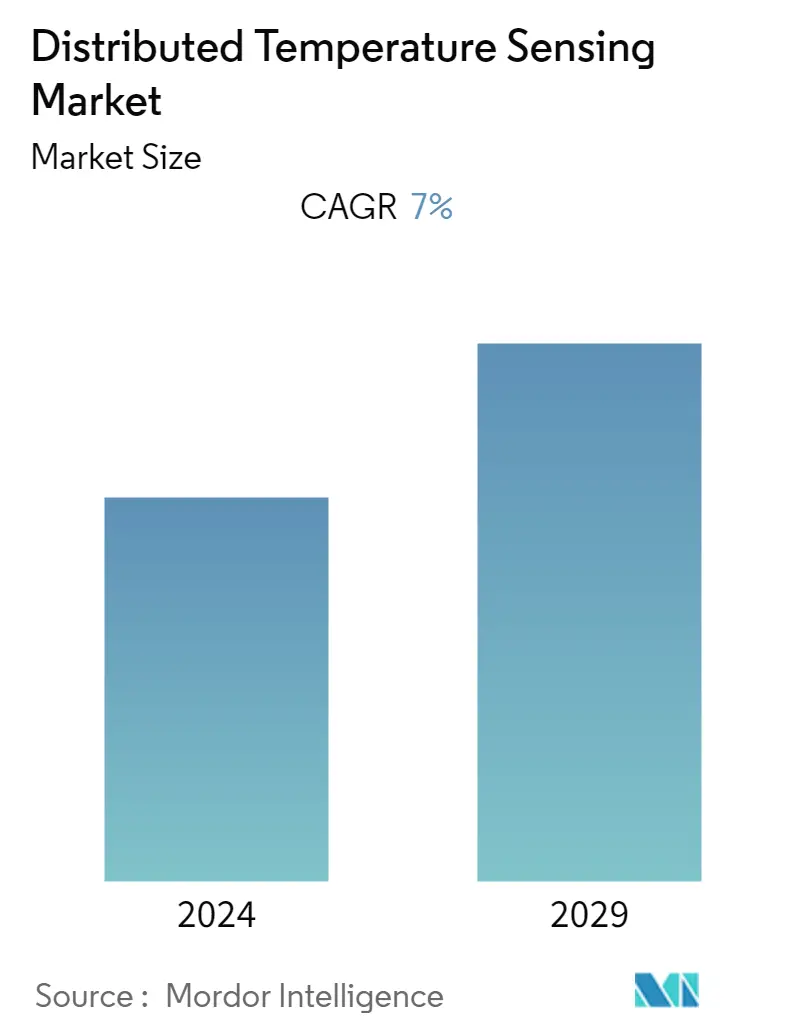Market Size of Distributed Temperature Sensing Industry

| Study Period | 2019 - 2029 |
| Base Year For Estimation | 2023 |
| Forecast Data Period | 2024 - 2029 |
| CAGR | 7.00 % |
| Fastest Growing Market | Asia Pacific |
| Largest Market | Asia Pacific |
Major Players
*Disclaimer: Major Players sorted in no particular order |
Need a report that reflects how COVID-19 has impacted this market and its growth?
Distributed Temperature Sensing Market Analysis
The Distributed Temperature Sensing Market is expected to register a CAGR of 7% over the forecast period 2021 to 2026. The deployment of power-efficient and miniaturized sensors along with the rising R&D expenditures by firms are some of the determinants expected to add significantly to the growth of the distributed temperature sensing market. Additionally, the growth of expensive multi-lateral hydraulic fracturing, larger focus on improving oil recovery, and the sustained strength of capital expenditure on thermally enhanced oil recovery systems provide the principal markets for the uptake of distributed temperature sensing.
- The investments in the industry to upgrade current infrastructure to support IoT and automation has been the principal trends impacting the industry, globally. In 2019, multimode fibers held the most significant size of the distributed temperature sensing market. Multimode fibers have a comparatively large light carrying core. These are extensively used in DTS applications and are available in core sizes of 50µm and 62.5µm.
- DTS technology has become an essential part of the oil & gas and power cable monitoring industry. DTS systems help in constant, real-time downhole monitoring to optimize the operational and economic performance of assets. This allows reservoir engineers to understand the injection and production dynamics better and, accordingly, maximize production and improve recovery, subsequently leading to enhanced profits. For instance, in Jan 2019, Yokogawa introduced TDLS8100 probe-type tunable diode laser spectrometer for use in oil, petrochemical, iron & steel, power, and other industries.
- Supportive government policies about safety and increase in industrialization & construction activities, mainly in technologically advancing countries such as China, India, and Brazil, drive the implementation of DTS systems rapidly. For instance, in Nov 2019, AP Sensing collaborated with Energinet, a Danish Transmission Operator, for offering a monitoring solution for the Kriegers Flak transmission system. AP Sensing is monitoring a total of 300 km, utilizing nine Distributed Acoustic Sensing (DAS) units and six Distributed Temperature Sensing (DTS) units. These DTS units with a range of 30-50 km and 1-4 channels are in the application for thermal profiling and to detect thermal anomalies.
- Various countries are extensively participating in formulating strict and obligatory OSH standards and legislations to ensure operational safety. Therefore, increasing safety norms and supportive government policies globally have accelerated the growth of the distributed temperature sensing market. However, higher infrastructure updating costs to maintain security needs stands as a significant challenge for the market.
- The COVID-19 outbreak and recent nationwide lockdown across the globe have effected the manufacturing activities, especially in Asia-Pacific, where a substantial portion of the globally distributed temperature sensors and other semiconductor components are manufactured. Although, in May 2020, many of these manufacturing sites are recovering and started their operations. However, the fluctuation caused in starting four months in 2020 could result in order delays and lead time across the sensors supply chain during 2020. However, the overall market is expected to recover in the long term and expand the scope of distributed temperature sensing across many new applications.
